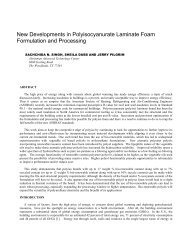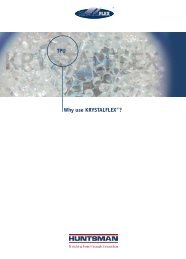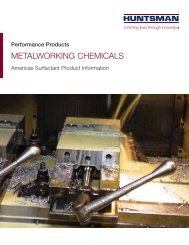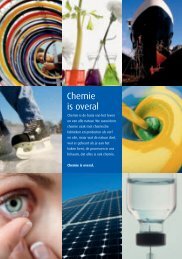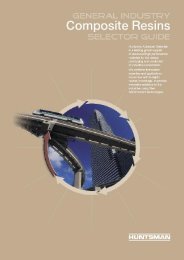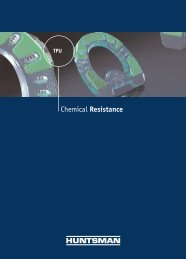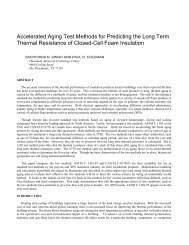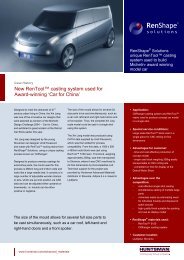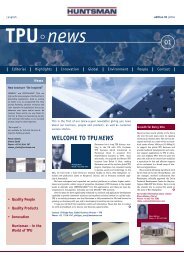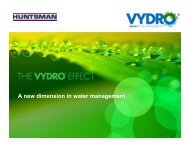Monomethylethanolamine (MMEA)
Monomethylethanolamine (MMEA)
Monomethylethanolamine (MMEA)
Create successful ePaper yourself
Turn your PDF publications into a flip-book with our unique Google optimized e-Paper software.
Technical Bulletin<br />
MONOMETHYLETHANOLAMINE (<strong>MMEA</strong>)<br />
<strong>Monomethylethanolamine</strong> is a clear, colorless liquid with an ammoniacal odor. It is miscible with water, alcohols,<br />
ethers, and aromatic solvents. Since it contains both a secondary amine group and a hydroxyl group, it undergoes<br />
reactions typical of both amines and alcohols.<br />
CH3NHCH2CH2OH<br />
APPLICATIONS<br />
<strong>Monomethylethanolamine</strong> is largely used as an intermediate in the manufacture of antihistamines such as<br />
diphenhydramine hydrochloride or for local anesthetics. It is also used in a number of cathodic electrodeposition<br />
coating systems. As a secondary amine, <strong>MMEA</strong> is used to chain-extend high MW polyepoxides. <strong>MMEA</strong> also has<br />
applications in textile treating. <strong>MMEA</strong> is used as a brightening agent in the dyeing of polyester/cotton blends.<br />
Mixtures of <strong>MMEA</strong>, dimethylethanolamine and methyldiethanaolmine salts of long-chain alkyl phosphates form<br />
antistatic agents for non-cellulosic, hydrophobic textile materials. <strong>MMEA</strong> can be reacted with methylmethacrylates<br />
to form the polyimid. Polymers produced from the methacrylates are useful as antistatic agents, soil conditioners,<br />
electrically conducting materials, paper auxiliaries and flocculating agents. Other suggested uses are textile<br />
softeners, pH control, and epoxy curing agents and photographic image developing.<br />
SALES SPECIFICATIONS<br />
Property Specifications Test Method*<br />
Appearance Clear and substantially free ST-30.1<br />
of suspended matter<br />
Color, Pt-Co 50 max. ST-30.12<br />
Equivalent weight 75.86 max. ST-5.5<br />
<strong>MMEA</strong>, wt% 99 min. ST-35.167<br />
Water, wt% 0.5 max. ST-31.53, 6<br />
Regulatory Information<br />
DOT/TDG Classification Corrosive liquids, toxic,<br />
N.O.S. (monomethylethanolamine)<br />
HMIS Code 3-2-0<br />
WHMIS Classification D1A, E, B3<br />
CAS Number 109-83-1<br />
Chemical Control Laws<br />
Canada, DSL Listed<br />
United States, TSCA Listed<br />
ADDITIONAL INFORMATION<br />
*Methods of Test are available from Huntsman Corporation upon request.<br />
Typical Physical Properties<br />
Boiling point, °C (°F) 158 (316)<br />
Flash point, PMCC, °C (°F) 71 (160)<br />
Freezing point, °C (°F) -4 (24)<br />
Specific gravity, 20/20°C 0.9<br />
Vapor pressure, mmHg, 20°C (68°F) 0.7<br />
Viscosity, cSt, 20°C (68°F) 14<br />
Water solubility (%) > 10<br />
TOXICITY AND SAFETY<br />
Acute Toxicity<br />
<strong>Monomethylethanolamine</strong> (<strong>MMEA</strong>) is considered to be slightly toxic by single oral exposures with an estimated oral<br />
LD 50 in rats ranging from 2.0 to 5.0 g/kg. It is considered to be moderately toxic by single dermal exposures, with<br />
an estimate dermal LD50 in rabbits ranging from 0.5 to 1.0 g/kg.<br />
<strong>MMEA</strong> is considered to be extremely irritating/corrosive to the skin of rabbits, with an estimated Draize dermal<br />
irritation score of 6.5 to 8.0 (maximum score 8.0). It is also considered to be extremely irritating/corrosive to the eyes<br />
of rabbits, with an estimated Draize dermal irritation score of 80 to 110 (maximum score 110).
Human Health Effects and First Aid<br />
On the basis of the above animal toxicity studies, the principal health hazard from accidental exposure to <strong>MMEA</strong> is a<br />
moderate to severe irritation/ corrosion of the eyes, skin, and mucous membranes. Chemical-type goggles with face<br />
shield must be worn during handling or use of the undiluted product or concentrated solutions. Contact lenses should not<br />
be worn. Protective clothing and gloves resistant to chemicals and petroleum distillates must be worn. Should accidental<br />
eye and skin contact occur, flush eyes with large amounts of water for at least 15 minutes, after which a physician should<br />
be consulted. During flushing of the eyes, eyelids should be held apart to permit rinsing of entire surface of eye and lids.<br />
For skin contact, immediately flush skin with large amounts of water for at least 15 minutes. Clothing wet with the product<br />
must be removed immediately and laundered before reuse.<br />
If <strong>MMEA</strong> is accidentally ingested and the individual is conscious and can swallow, they should be given two large<br />
glasses of water, after which a physician should be consulted. Since this product is expected to produce severe<br />
irritation/corrosion of mucous membranes, vomiting should not be induced due to the possibility of lung damage from<br />
aspiration of the product into the lungs during vomiting.<br />
Under usual circumstances of handling and use, exposure to harmful quantities of <strong>MMEA</strong> vapor should not occur.<br />
However, certain situations such as poorly ventilated areas or heating of <strong>MMEA</strong> can result in exposure to appreciable<br />
concentrations of <strong>MMEA</strong> vapors, resulting in irritation to the eyes, nose, and throat, and producing temporary and<br />
reversible hazy or blurred vision. These symptoms disappear when exposure to <strong>MMEA</strong> is terminated. Adequate<br />
ventilation should be provided where a large quantity of product is exposed or where mists or vapors are generated.<br />
Spills in confined areas should be cleaned up promptly using appropriate personal protective equipment. For further<br />
information, please refer to the Material Safety Data Sheet (MSDS) for this product.<br />
HANDLING AND STORAGE<br />
In order to maintain the high degree of purity with which <strong>MMEA</strong> is manufactured and shipped, the following storage and<br />
handling considerations are recommended:<br />
Dry Inert Gas Blanket: This product should be stored under a dry inert gas blanket such as nitrogen to minimize<br />
contamination resulting from contact with air and water.<br />
Materials of Construction: Clean carbon steel is satisfactory as a material of construction for storage tanks and transfer<br />
systems, provided adequate precautions are observed to guard against rust contamination. In those cases where<br />
additional precautions are needed to preserve low color, stainless steel or aluminum should be used. Aluminum should<br />
not be used at elevated temperatures. Copper or alloys containing copper should be avoided. Carbon steel centrifugal<br />
pumps are satisfactory. Polypropylene or Teflon is the recommended gasket material. Nitriles such as Buna N or Viton<br />
should be avoided. Storage Temperature: <strong>MMEA</strong> freezes at approximately 24°F and may need heating unless stored<br />
inside.<br />
Spills or Leaks: Eliminate all sources of ignition in case of spills or leaks. Spills should be removed by absorbent<br />
materials or by contained water washing.<br />
AVAILABILITY<br />
<strong>Monomethylethanolamine</strong> is available in bulk and in 55-gallon drums. Samples are available by contacting our sample<br />
department at 1-800-662-0924.<br />
Huntsman Corporation<br />
Business Offices<br />
10003 Woodloch Forest Dr.<br />
The Woodlands, TX 77380<br />
(281) 719-6000<br />
Huntsman Advanced Technology<br />
Center<br />
Technical Service<br />
8600 Gosling Rd.<br />
The Woodlands, TX 77381<br />
(281) 719-7780<br />
Samples 1-800-662-0924<br />
www.huntsman.com<br />
Copyright © 2007, 2008 Huntsman Corporation or an affiliate thereof. All rights reserved.<br />
5010-0708<br />
Huntsman Corporation warrants only that its products meet the specifications stated herein. Typical properties, where stated, are to be considered<br />
as representative of current production and should not be treated as specifications. While all the information presented in this document is<br />
believed to be reliable and to represent the best available data on these products, HUNTSMAN MAKES NO WARRANTY OR GUARANTEE OF<br />
ANY KIND, EXPRESS OR IMPLIED, INCLUDING BUT NOT LIMITED TO ANY WARRANTY OF MERCHANTABILITY OR FITNESS FOR A<br />
PARTICULAR PURPOSE, NON-INFRINGEMENT OF ANY INTELLECTUAL PROPERTY RIGHT OF ANY THIRD PARTY, OR WARRANTIES<br />
AS TO QUALITY OR CORRESPONDENCE WITH PRIOR DESCRIPTION OR SAMPLE, AND ANY USER OF PRODUCTS DESCRIBED<br />
HEREIN SHOULD CONDUCT A SUFFICIENT INVESTIGATION TO ESTABLISH THE SUITABILITY OF ANY PRODUCT FOR ITS INTENDED<br />
USE AND ASSUMES ALL RISK AND LIABILITY WHATSOEVER RESULTING FROM THE USE OF SUCH PRODUCT, WHETHER USED<br />
SINGLY OR IN COMBINATION WITH OTHER SUBSTANCES. Product(s) described in this publication may be hazardous and/or toxic and<br />
require special precautions in handling. For all product(s) described herein, the user should obtain from Huntsman detailed information on hazards<br />
and/or toxicity, together with proper shipping, handling, and storage procedures, and should comply with all applicable safety and environmental<br />
standards. The behavior, hazards and/or toxicity of the product(s) referred to in this publication in manufacturing processes and their suitability in<br />
any given end-use environment are dependent upon various conditions such as chemical compatibility, temperature, and other variables, which<br />
may not be known to Huntsman. It is the sole responsibility of the user of such product(s) to evaluate the manufacturing circumstances and the<br />
final product(s) under actual end-use requirements and to adequately advise and warn future purchasers and users thereof.



